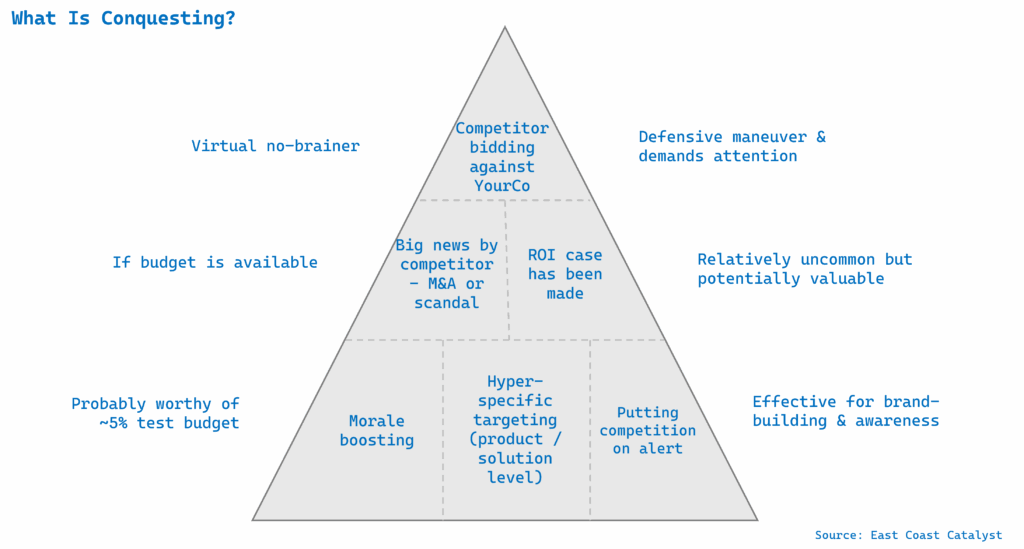What Is Conquesting?
Conquest advertising captures the attention of many senior executives, both marketing and non-marketing alike.

NEED TO KNOW
- Conquesting advertising is running ads against competitor brand names and trademarked terms
- It primarily involves search engine marketing on Google and Bing
- It’s appealing on a visceral level because it speaks to the competitive spirit
- Conquesting can be effective for brand building and morale but ROI can be elusive
Here are six factors for B2B marketers to consider when formulating conquesting advertising strategies.

- ENCROACHMENT. There may be a good reason why a competitor is bidding on your organization’s branded terms — company, product or service names like Apple, MacBook and iPhone — but it’s not relevant. The only issue that matters is that the competitor is occupying the top spot in search engine results pages (SERPs) and that’s an issue because as many as 25% of users click on the first result. In this example, a brand must decide how to respond to a competitor’s conquesting advertising.
Anything disrupting a customer or prospect’s journey to an intended destination is potentially problematic. This is much more of an issue in B2C because of the pervasiveness of impulse buys but it’s not uncommon in B2B, especially in competitive, early-stage categories, where well-funded companies are jockeying for first mover advantage.
Pro Tip: if competitors are bidding on your company’s branded terms, there’s probably a good reason; respond in kind or suffer the consequences – performance-based and otherwise. The good news is that it doesn’t break the budget at $1-$3/click, though it’s not unusual for larger B2B companies with robust marketing operations to allocate as much as 50% of digital ad spending to branded terms (the opposite of conquesting, effectively). - ROI. The biggest challenge in competitive conquesting advertising is making the ROI case work. While Google and Bing allow conquesting, with some modest restrictions, the costs are typically steep. When other, low-funnel, close-to-purchase keyword inventories are available, the ROI case can usually be made more easily and so that’s where B2B advertising budgets tend to gravitate.
Continuing with the Apple example: it might make sense for Lenovo or HP to run ads against “Macbook” searches. Across tens of thousands of searches every month with the term included, especially ones like “how much does a Macbook cost?” (1,900 searches / month), it stands to reason that a few of them will be open to the idea of a PC versus a Mac, especially if costs are an important consideration. But wouldn’t advertising dollars be better spent on user searches on keyword strings like “best budget laptop”?
With big enough budgets, these trade-offs don’t matter much because those situations allow marketing teams the ability to conduct almost unlimited testing. But huge budgets are uncommon. The majority of B2B marketers need to make strategic decisions about how to allocate spending and because conquesting can be so pricey to test, it’s often avoided altogether.
Takeaway: Conquesting can accommodate ROI requirements in specific situations, such as in relatively low-cost B2B categories and when combined with compelling offers, like free trials; but there are usually more attractive and active keyword clusters to prioritize. - SCANDAL. Conquesting can be deployed successfully as a sort of crisis response tool when competitors get embroiled in scandal or are in the news because of a merger or acquisition or other high profile activity. These situations often catalyze interest and the resulting spike in keyword inventory can be taken advantage of. It can cause customers and prospects pause, and to seek out alternative solutions that they otherwise might not have considered.
Consider the recent example of Astronomer, which had two senior executives caught on camera behaving badly at a concert. Interest in the company skyrocketed in the following days, with website traffic increasing by 15,000%. This also raised awareness for Apache Airflow, the platform its products are built on, and any company in the category could’ve found ways to hack into the activity and raise its profile in the aftermath.
Pro Tip: While not an absolute requirement, marketing teams will be well-served by preparing to take advantage of news events before they happen; this can be done by running simulations or gaming out different scenarios that will benefit from unique approaches depending on the type of event — scandal, acquisition, product failures, etc. - MORALE. Over the past couple of decades, marketing and advertising has come full circle relative to the “I know half of my ad budget is working, I just don’t know which half” environment that characterized much of the latter half of the 1900s. Indeed, many B2B organizations are taking tracking, reporting and attribution to another level nowadays. It’s not unusual for companies that are aggressive adopters of new marketing tactics to have a dozen people on analytics teams.
But a reasonable case can be made that the underlying purpose of most marketing campaigns are two-fold: to affect behavior of customers and prospects, and to invigorate staff. This is especially true with efforts like a corporate rebrand, new website launch, or community outreach program. Conquesting campaigns can serve this purpose as well.
Pro Tip: Announcing a 90-day conquesting initiative during a companywide meeting can invigorate staff and help to instill swagger. - TARGETED. Campaigns oriented around competitor brand terms often make the most sense when hyper-targeting is involved. In this context, targeting can mean limiting the advertising to a product feature, geographic territory, or specific companies — all of which are doable via Google Ads or Microsoft/Bing Ads.
Example: fictional Acme Corporation just launched an innovative new software product targeted at large financial companies that can be used along with existing ERP systems. The company’s go-to-market strategy involves getting financial services analysts to use the tool by offering a free 90 day trial. To recruit users, the company needs to get its pitch in front of this hard-to-reach audience, and the best way to do it could be via their online support/research behavior. So anytime someone searches for “how to X in software Y”, their ads run, but only in financial services hubs Charlotte, Chicago, Denver, New York and San Francisco, and only get served to a specific set of a few hundred companies that fit the ICP requirements.
Pro Tip: The execution described here isn’t as complicated as it might sound but given its narrow focus might require a 90 day test versus 30 or 45 days in order to gather enough performance data — assuming it works at all. - ALERT. Saving the most interesting take for last, conquesting is extremely effective at getting the attention of a competitor. The activities will be shared in monthly reporting and inevitably make their way to non-marketing executives at the competition. It’s not unrealistic for the CEO of a multibillion company to be notified about competitor conquesting, if only to be kept up to date on market conditions.
This tactic can be desirable for the conquesting company for many reasons, not the least of which is chain-rattling at a potential acquirer. Conquesting is used more frequently by early-stage companies that commonly deploy aggressive tactics to get seen than by larger, more established organizations. Smaller companies also have less to lose, so bending rules or circumventing regulations could be part of the business plan.
Takeaway: Notwithstanding a major PR coup, scandal or game-changing new customer acquisition, conquesting is one of the more effective tools available for small companies to get on the radar of executives at well-established and larger competitors.
RESOURCES & FURTHER READING
- B2B Digital Marketing Case Studies
- Does PPC Work For B2B?
- Is It Time For a PPC Audit
- Marketing Audit Services
#############t###############################
Tim Bourgeois is a B2B marketing strategy consultant at East Coast Catalyst and manages the PPC management services practice. Contact him at tbourgeois(a)eastcoastcatalyst.com to discuss how his team can help with B2B digital marketing strategy and lead generation initiatives.
